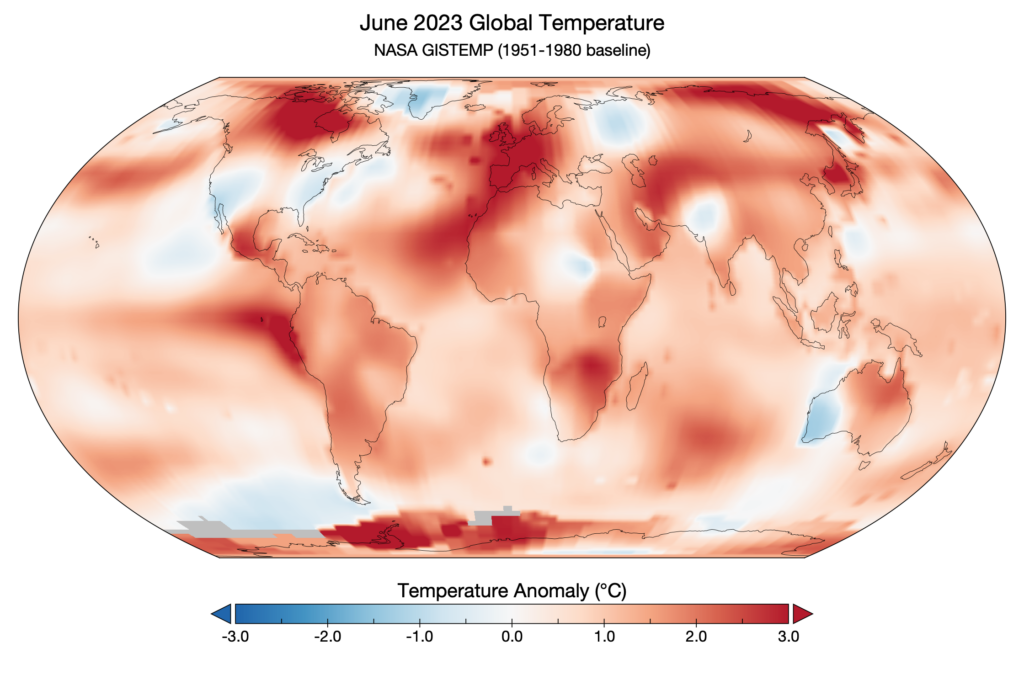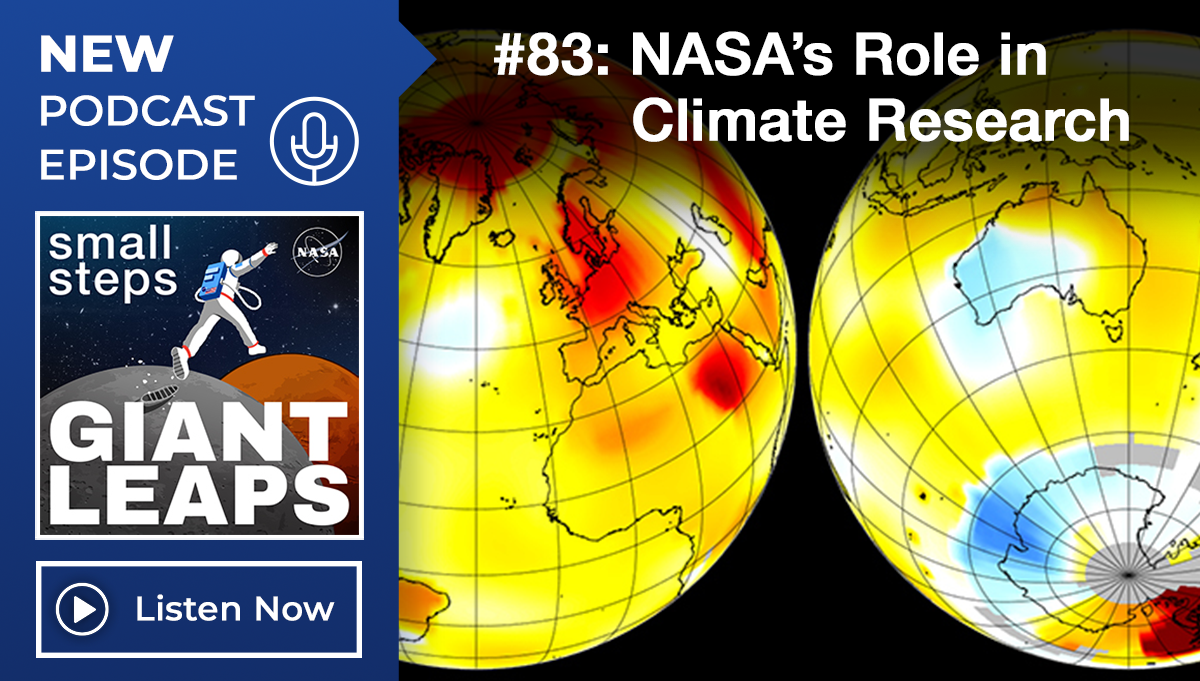
NASA studies Earth with a fleet of more than two dozen satellite missions that gather data about land masses, ice prevalence, atmospheric conditions, oceans, and more.
Image Credit: NASA Goddard Space Flight Center.
Difficult summer highlights data NASA collects on Earth’s climate.
The summer of 2023 began with thick smoke from Canadian wildfires filling the skies of heavily populated U.S. cities. Hot temperatures, strong winds, and extreme drought in the remote forests of Canada have driven what is already the country’s most destructive fire season—more than 25 million acres burned—with more than a month of peak conditions remaining.
In July, hundreds of millions of people in vast swaths of the northern hemisphere sweltered under incredible heat. In the remote village of Sanbao, China, the high temperature on July 16 hit 125.6° F, a new national record for the date, topping the old record by more than 2 degrees. Italy, Spain, and Greece faced heat waves that pushed temperatures well beyond 100° F. The island of Sardinia reached a high temperature of 118.4° F, a new record for Europe in July. The heat in Europe has contributed to large wildfires.
Extreme heat affected the southern U.S., with millions of residents from Arizona, Arkansas, California, Mississippi, Nevada, New Mexico, Oklahoma, and Texas under excessive heat advisories. Temperatures in Phoenix, Arizona exceeded 110° F for more than 25 consecutive days—a record—with 11 of those days exceeding 115°. In late July, buoys off the south coast of Florida recorded sea surface temperatures above 100° F.

This map shows global temperature anomalies for June 2023 according to the GISTEMP analysis by scientists at NASA’s Goddard Institute for Space Studies. Temperature anomalies reflect how June 2023 compared to the average June temperature from 1951-1980.
Infograph Credit: NASA’s Goddard Institute for Space Studies
“The last nine years have been the warmest since modern record keeping began. We’re on a trend of increasing temperatures and with those increasing temperatures we are seeing more impacts and that’s something that we as scientists have known for a while,” said Kate Calvin, NASA Chief Scientist and Senior Climate Advisor, speaking at a NASA media briefing. “I think what’s sometimes different for people is when you actually experience it in your neighborhood.”
NASA held the media briefing on July 20 to draw attention to the agency’s work studying the Earth’s climate with a fleet of more than two dozen satellite missions that gather data about land masses, ice prevalence, atmospheric conditions, oceans, and more. Studying this data can also point to how changes in one area drive changes in others.
“…This wide diversity of observations, sustained over time, has taught us actually much of what we understand about how and why the Earth system, including climate, is changing,” said Dr. Karen M. St. Germain, Director of NASA’s Earth Science Division. “The study of climate is the study of carbon cycle and ecosystems, atmospheric composition, water and energy cycle, climate variability and change, weather and atmospheric dynamics. In other words, there’s a lot to understand here. And while climate is not just long-term weather, most of us will experience climate change through severe weather, which we’ve seen recently with drought and heat in the southwest, flooding in Vermont and the atmospheric rivers in California earlier this year.”
On June 20, NASA Administrator Bill Nelson officially opened a new Earth Information Center, which includes a physical location at NASA Headquarters in Washington, D.C., and a corresponding Earth Information Center website. The new center demonstrates how data from NASA’s missions can help people who face natural disasters, environmental challenges, and the impacts of climate change.
“For more than 60 years, NASA has used our vantage point of space to observe Earth with satellites and instruments aboard the International Space Station to collect vital, life-saving data,” Administrator Nelson said, in a NASA press release. “To meet the Biden-Harris Administration’s goal of making this data more understandable, accessible, and usable for everyone, NASA is opening the Earth Information Center. From firefighters that rely on NASA data for wildfire management to farmers who need to know when and where to plant crops, the Earth Information Center will help more people make informed decisions every day.”
The Earth Information Center has links to informative articles, videos, and podcasts about agriculture, air quality, biodiversity, energy, greenhouse gas emissions, sea level rise, wildfires, and more. It also contains a tool to compare air quality in countries and cities around the world based on factors including particulate matter, carbon monoxide, ozone, and sulfur dioxide.
“We are seeing unprecedented changes all over the world. The heat waves that we’re seeing in the U.S., in Europe, in China are demolishing records,” said Gavin Schmidt, Director of NASA’s Goddard Institute for Space Studies, speaking at the media briefing. “This is not a surprise. We have been tracking the changes in temperature over time since the 1980s when we first started to put together global estimates of how temperatures are changing. Those records go back to the late 19th century, and we can see that there has been a decade on decade increase in temperatures throughout the last four decades.”
“This last June was the warmest June on record, and we anticipate—with the understanding of what’s going on, on a day-by-day basis—that July is likely to be the warmest absolute month on record,” Schmidt said, noting data for that record goes back many hundreds of years. “We don’t see this every year.”
Weak El Niño conditions developing now in the tropical Pacific are likely to grow stronger into the winter, with intensity peaking between November and January, reaching the moderate to strong intensity range, according to the National Oceanic and Atmospheric Administration.
“What’s happening now is certainly increasing the chances that 2023 will be the warmest year on record. My calculation suggests that that’s right now about a 50/50 chance. Others have suggested it’s more like an 80 percent chance,” Schmidt said. “But we anticipate that 2024 will be an even warmer year because we’re going to be starting off with that El Niño event that’s building now.”









